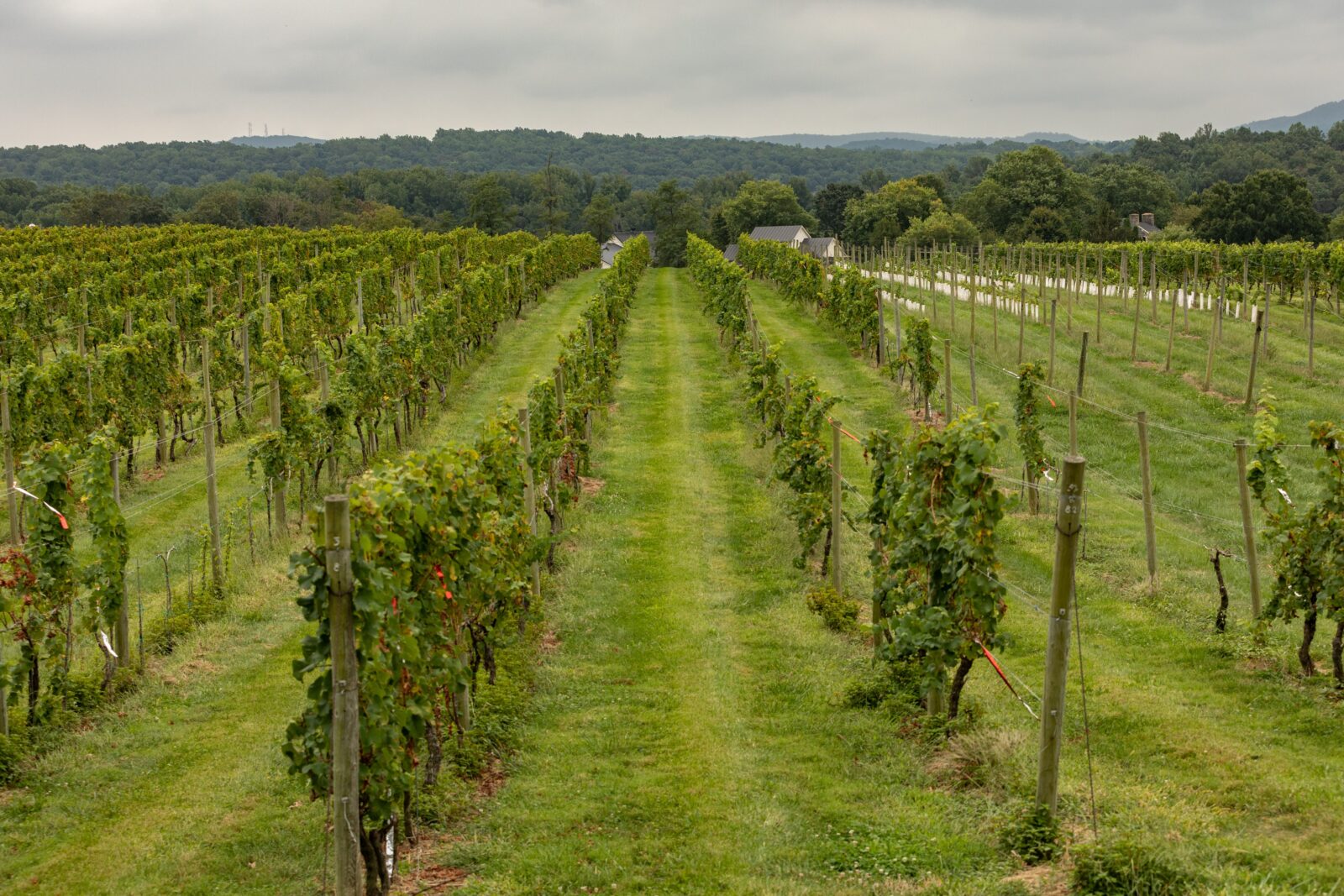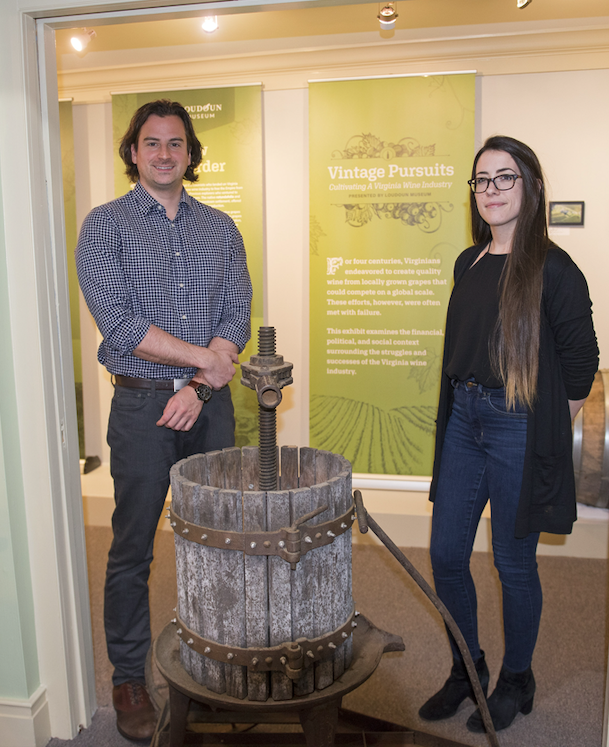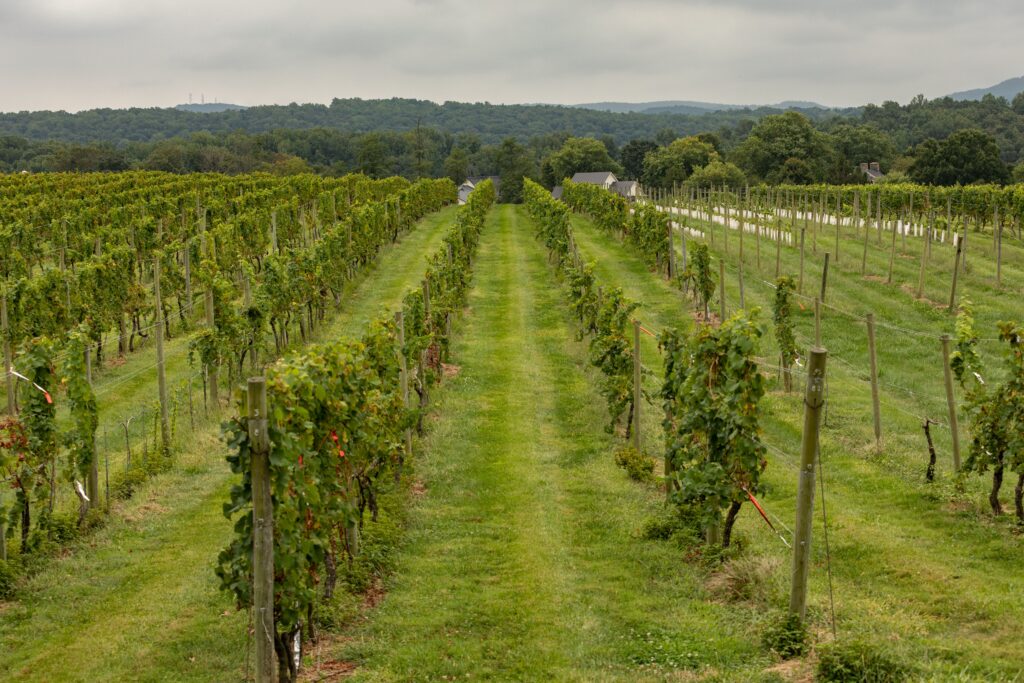Virginia and Vino—A Perfect Pairing

By Heidi Baumstark
When casks of European wine washed ashore on the dunes of Virginia’s Cape Henry, a band of English settlers took notice. That was April 26, 1607 when explorers made landfall there before founding Jamestown, the nation’s first permanent English settlement, on May 14, 1607.
Ever since, Virginians have continued their discovery for indulging in vintage pursuits. And a new exhibit at the Loudoun Museum is called just that: “Vintage Pursuits: Cultivating a Virginia Wine Industry,” which satisfies the curiosity of those interested in examining the economic, political, and social context surrounding the ups and downs of Virginia’s 400-year wine industry. The exhibit opened Feb. 14 and will be up throughout 2020.
Dr. Joseph Rizzo, executive director of Loudoun Museum, has been with the museum since Nov. 2018. Prior, he was curator at Drayton Hall in Charleston, South Carolina, an 18th century property known as the oldest preserved plantation house in America still open to the public. He spent summers working at battlefield parks, including nearby Manassas National Battlefield Park from 2009-2011, before earning his Ph.D. in 19th century history politics.
This new exhibit has a traveling component that consists of six pop-up panels with text, old black-and-white photos/maps, and graphics, allowing history to be brought to the people. Rizzo explained, “We can take it on the road to wineries, festivals, conventions, etc. We use it as a mini fundraiser and to educate people about Virginia’s wine history.”
Andrea Ekholm, the museum’s visitor experience manager, has a master’s degree in museum studies. She noted, “Recently it was on display at Doukenie Winery in Hillsboro.” The panels chronical Virginia’s wine industry from 1607 to today’s 40-plus wineries and tasting rooms in Loudoun, proudly and accurately promoting itself as “D.C.’s Wine Country.”

Loudoun Museum professionals Dr. Joe Rizzo and Andrea Ekholm at the new Vintage Pursuits exhibit. Photo by Joanne Maisano
On March 5, the museum—housed in an historic 19th-century building in downtown Leesburg—hosted a book talk by Andrew A. Painter, author of “Virginia Wine: Four Centuries of Change,” which covers the history of wine making in Virginia. Loudoun wine samples were served, paired with cheese and crackers. Rizzo thanked Visit Loudoun who sponsored the lecture and creates the popular Wine Trail Maps for the county.
Painter, of Falls Church, opened with, “I’m not an historian; I’m a lawyer here in Leesburg. I was bread and buttered in northern Virginia.” He started the book in 2008; and almost 500 pages later, the book was published in 2018 by George Mason University Press. “I dedicated the book to my wife, Mary Anne. She was patient as I spent lots of time interviewing people and at libraries, including Leesburg’s Thomas Balch Library,” he said.
The museum exhibit describes how for four centuries, Virginians endeavored to create wine from local grapes that could compete on a global scale. But those efforts repeatedly failed. The British government hoped that the colonists who landed on Virginia shores in 1607 would create a new wine industry, freeing the English from their reliance on the French for wine.
Previous explorers who ventured to the New World noted an abundance of wild grapes, but soon realized that native grapes came with several challenges: lacking sugar and having a high acid content. Colonists’ initial attempts resulted in unpleasant wines described as musty and foxy. In Painter’s lecture, he said that Captain John Smith (1580-1631) wrote about the grapes he saw in Virginia. “In 1610, the Virginia Company ordered colonists to plant vines. In 1612, a death penalty was imposed for ‘disturbing grapes,’” he added.
To improve the prospects of wine production, the Virginia House of Burgesses passed several acts and initiatives. Among the most prominent was Act 12, passed during their first meeting in 1619, which required every colonist to plant and maintain 10 vines. This was followed by another act in 1624, requiring every free man over age 20 to plant and maintain 20 vines. The Virginia Company also sent eight French wine experts to share their expertise to tend to 10,000 newly imported European vinifera vines. “Virginia’s dominant agriculture was tobacco, but by 1750, there was a renewed interest for agriculture diversification,” Painter said.
Thomas Jefferson (1743-1826), Virginia’s second governor in office 1779-1781, was a wine connoisseur and meticulously researched the process of growing grapes while in Europe. He hoped to replicate European business and social practices surrounding wine. However, Painter said Jefferson “never produced a single bottle of wine, though he is known today as at the ‘Father of American Wine.’”
In 1787 Jefferson fractured his right wrist and traveled to the South of France and Italy “to recover” at the advice of his surgeon. Painter said, “Jefferson was armed with a corkscrew and it educated him about wine and how to properly serve it. He believed that wine had a positive effect.” As the nation’s third president from 1801 to 1809, he “stocked his White House with 20,000 bottles of wine,” Painter explained. George Washington shared Jefferson’s belief that Virginia could have a wine industry; after all, he had a distillery at his Mount Vernon estate.
Virginians still persevered in seeking how to produce grapes for wine despite botched attempts in the 17th and 18th centuries. But the real reason for the difficult wine industry was diseases on native grapes. Still, Virginians kept up their persistence. The best hybrid was the native Norton grape named after Dr. Daniel Norborne Norton (1791-1842), a Richmond surgeon. One of the museum panels states that “overcome with grief after the passing of his wife,” he dedicated his energies to viticulture experimentation.

Photo by Tony Gibson
The Norton grape was introduced in Richmond in the 1830s, transforming American viticulture. The museum exhibit includes a bottle of Norton Reserve 2000; the label is signed “Very 1st bottle” by Chrysalis Vineyards’ owner Jennifer McCloud, who is credited to restoring the native Virginia Norton grape, promoting sustainable, responsible land use on her Middleburg vineyard. Success was found in crossbreeding and discovering that the Norton grape produced European-style wine resistant to diseases. By the 1850s, Norton was a widely planted varietal in Virginia, and the newly laid railroads could truck out fruit by train. Things were looking up.
But then entered the Civil War.
Four years of war (1861-1865) ravaged Virginia’s countryside, further disrupting attempts at grape growing. Locally, the Battle of Upperville unfolded on June 21, 1863 on Vineyard Hill along today’s Route 50, destroying vines. At the war’s end, some Virginians saw a return to growing fruits and wine grapes to help the struggling postwar economy. This new emphasis ushered in the first successful period for the Virginia wine industry; and by 1870, Virginia grew 3,000 acres of grapes and annually produced 26,283 gallons of wine. By 1890, it rose to 4,100 acres yielding 461,000 gallons of wine annually.
German immigration to Northern Virginia also contributed to this newfound success. Many immigrants proved adept at viticulture, helping to develop Virginia’s wine industry and wine companies. With local vineyards’ successful cultivation of hybrid grapes—and a growing market for wine—Virginia’s wine industry prospered in the latter half of the 1800s. But that would be short lived.
Then came Prohibition.
In the early 20th century, state and national laws halted the industry almost entirely. The museum exhibit shows a 1909 map of Virginia distinguishing between “wet” and “dry” parts of the state. Although wine was less restricted than hard liquor due to its medicinal and religious applications, it was through these legal loopholes that Virginia wine became amateurly produced. Due to cheaper methods and less refined varietals, Virginians turned away from the European ideals promoted by Jefferson. To mask the flaws of these wines, producers often added brandy and sugar. It would take decades before winemakers and consumers returned their attention to higher quality and drier varietals.
Ironically, Painter said the first Virginia county to ban alcohol was Albemarle, the home of Jefferson’s Monticello estate. The effect of Prohibition devasted the nation; it led to lawlessness, the decline of wine culture, and to “bathtub distilling.” Temperance groups like the Good Templars of Loudoun County sought to educate citizens on the social and physical harms caused by alcohol. This led to Virginia passing a referendum approving statewide Prohibition in 1916—three years before the 18th Amendment was ratified Jan. 16, 1919 (and went into effect one year later, on Jan. 17, 1920), setting federal restrictions on the manufacture and sale of alcohol.
Even after Prohibition was repealed by the 21st Amendment, which was ratified Dec. 5, 1933, Virginia’s laws regarding alcohol continued to limit the wine industry. Local wineries struggled to profit under a three-tiered system that separated manufacturers, wholesalers, and retailers. But the 1980 Virginia Farm Winery Act was passed, providing helpful tax relief for “farm wineries” that differed from those labeled as “commercial wineries;” and it allowed wineries to sell directly to consumers, removing the three-tiered system. Direct marketing and distribution benefits enabled farm wineries to more effectively compete in a packed marketplace dominated by California wines.
Good news was on the horizon.
State agencies began providing funding to assist local winemakers. Marketing initiatives sprung up. Local wine festivals began popping up. October was named Virginia Farm Winery Month, now known as Virginia Wine Month. State tourism developed promotional campaigns, helping the wine industry to take off as agritourism became increasingly popular with farm-to-table movements. This—along with agricultural improvements—greatly advanced the potential for success.
Entrepreneurs like Lew Parker experimented with growing European varietals that had been abandoned during Prohibition. He ushered Loudoun into the wine industry opening Willowcroft in Leesburg, the county’s first winery in 1984. Since then, with favorable zoning regulations and the county’s rural economic development marketing initiatives, in 2008, Visit Loudoun rebranded its tourism efforts naming the county “D.C.’s Wine Country” with its proximity to the nation’s capital. Visit Loudoun produced a glossy winery touring guide serving as the county’s primary marketing piece. Today, Loudoun tops the list with the most wineries in Virginia.
Master marketing continued. In 2011, a Virginia winery scene was chosen as the front cover of the Virginia Tourism Guide. Painter added, “Local wine spurs on many things: historic trust properties found a new way to market themselves, attracting visitors by serving wines.”
Painter’s book sums it up by stating that the Old Dominion has established itself as one of the nation’s preeminent wine regions, which now accounts for nearly $1 billion in annual sales with over 275 wineries growing more than 30 varieties of grapes. “It’s our history, our beautiful scenery. It’s all complimentary creating a whole new experience,” he said. “We’re now consistently recognized in wine magazines. Virginia is named one of the top ten wine destinations in the world. We are now the “wettest” state with 65 of Virginia’s 95 counties producing wine.” And the state’s modern wine industry is just about 35 years old.
Dave Kreager, of Leesburg, attended Painter’s lecture at Loudoun Museum where he volunteers; he is also on the board of the Friends of Ball’s Bluff Battlefield, which commemorates the Oct. 21, 1861 battle in Leesburg where Union forces suffered a humiliating defeat. “I’ve volunteered at the museum for about a year. I’m all about preservation and education, and this is a great venue to promote history.”
Stephanie Burch, of Centreville, was visiting Leesburg on a Saturday afternoon and discovered the museum. “I didn’t know this museum was here. We were walking around old town and saw it. I’m a wine lover and am interested in local wines.” Pointing to an old wooden wine press in the exhibit, she said, “This old press is really cool. I want to taste more Virginia wines; I wonder what will continue to do well here in Virginia.”
Rizzo added, “We thought, ‘Why are people coming to Loudoun?’ It didn’t take long to discover that wineries are bringing people here, so we developed this exhibit.”
Looks like the pursuit for exploring Virginia wine remains strong.
Loudoun Museum is located at 16 Loudoun Street, S.W. in old town Leesburg; operating hours are 10 a.m. – 4 p.m. on Friday, Saturday and Sunday. For more information, call 703-777-7427 or visit loudounmuseum.org. ML
Due to COVID-19, the Loudoun Museum is closed as a precaution until further notice. Follow the Museum on Facebook for programming updates.
This article first appeared on April 27, 2020 at Middleburglife.com


